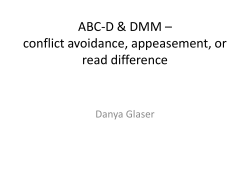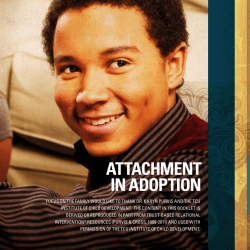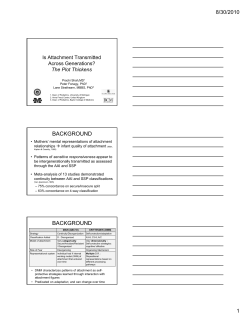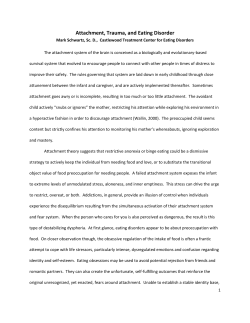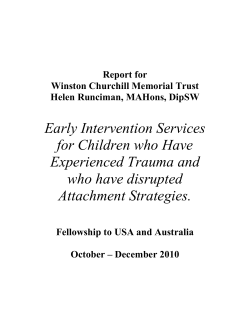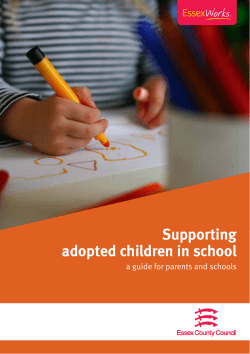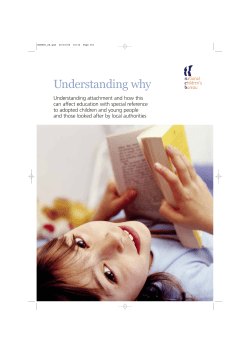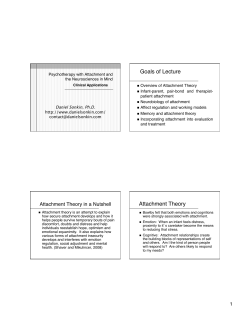
EFFECTS OF ATTACHMENT ON EARLY AND LATER DEVELOPMENT Introduction Mokhtar Malekpour
The British Journal of Developmental Disabilities Vol. 53, Part 2, JULY 2007, No. 105, pp. 81-95 EFFECTS OF ATTACHMENT ON EARLY AND LATER DEVELOPMENT Mokhtar Malekpour Introduction There is no doubt that early experience influences later development. This influence could account for individual differences in many aspects such as cognition, behaviour, social skills, emotional responses and personality. Some developmentalists assert that early experience guarantees long-term developmental outcomes or protects against subsequent trauma (Sroufe and Jacobvitz, 1989). Early experiences, especially emotionally or affectively charged experiences with other humans, induce and organize the patterns of structural growth that result in the expanding functional capacities of a developing individual. Schore (1994) points out that these early experiences shape the development of a unique personality, its adaptive capacities as well as vulnerabilities to and resistances against particular forms of future pathologies. Research over the course of past 30 years demonstrated that upon birth infants are far more competent, social, responsive and more able to make sense of his or her environment than we ever imagined. The infant is no longer regarded as passive, responding only to stimuli (Fantz, 1963). Detailed studies of the amazing behavioural capacities of the normal neonate have shown that the infant sees, hears and moves in rhythm with his/her mother’s voice in the first minutes and hours of life, resulting in a beautiful linking of the reactions of the two and a synchronized “dance” between the mother and the infant (Klaus and Kennel, 1982). However, it is important to realize that the infant can only be competent in the context of a relationship. Therefore, an infant is born expecting a competent caregiver to pay attention to and care for him or her. Winnicott (1965), in a beautiful statement puts this in this way: “A baby alone does not exist.” Among the many different relationships individuals form during the life span, the relationship between mother and child is the most important. This relationship will mediate mother-child attachment. Fraiberg (1959) writes: “Our personal identity - the very center of our humanness - is achieved through the early bonds of child and *Professor Mokhtar Malekpour, Ph.D. Graduate School, Islamic Azad University Khorasgan Branch, Isfahan, Iran Tel: +98-311-7932568 or 7932558 Fax: +98-311-6687396 E-mail: marjan_682002@yahoo.com * For Correspondence 81 parent. Conscience itself, the most civilizing of all achievements in human evolution, is not part of constitutional endowment, but the endowment of parental love and education”. Attachment theories have made important contributions to the notion of early experience. Attachment theory was developed by British psychologist and psychoanalyst John Bowlby. According to Bowlby (1973, 1980), experience with primary caregivers leads to generalized expectations and beliefs (“working models”) about self, the world, and relationships. He describes these representations as persistent and yet open to revision in light of experience. Persistent attachment representations allow positive secure base experiences to guide behaviour when someone “stronger and wiser” is not at hand (Bowlby, 1985). The early relationship between caregiver and baby acts as an external system for the child’s internal regulation. Attachment is, in many ways, a measure of self-control. The growing infant who began being totally dependent on mother for soothing, stimulation and emotional regulation, gradually claims the ability to manage alone. In other words: “early development entails the gradual transition from extreme dependence on others to manage the world for us to acquiring the competencies needed to manage the world for oneself ” (Shonkoff and Phillips, 2000). Definitions of Attachment The notion of attachment has been defined in different ways, but something which is identical in all definitions is that attachment is an essential ingredient for normal human development. Bowlby (1977) defines attachment as an enduring emotional bond which an 82 individual forms to another person. Papalia et al., (1999) define it as a reciprocal, enduring, relationship between infant and caregiver, each of whom contributes to the quality of the relationship. Attachments have adaptive value for babies, ensuring that their psychosocial as well as physical needs will be met. According to Ainsworth (1979), it may be "an essential part of the ground plan of the human species for an infant to become attached to a mother figure". In general, attachment is the emotional bond that individuals form with their caregivers over the course of their infancy. The quality and timing of attachment could determine the quality of later development. Patterns of Attachments Attachment can be divided into two main categories: secure and insecure attachments. Insecure attachment itself has three different types namely: insecureavoidant, insecure-ambivalent and insecure-disorganised. 1. Secure Attachment The parent-child relationship serves as a prototype for future relationships of the child. It is this first relationship that the child uses as a template to apply to future relationship experiences. In short, the quality of early relationships predict later relationships, and success in later relationships takes root in the context of the parent-child relationship (Gearity, 2005). Gearity (2005) proposes that the parent and child, as partners, must accomplish two basic goals that serve as the foundation for healthy relationships with others in the future: (1) the establishment of a basic sense of trust in the world "when I need you, you will be there" and (2) the allowance for emotional regulation - the expression of feelings, along with the underlying physiological patterning. When these two goals are successfully met, it is likely that the child will experience a satisfactory attachment relationship with his or her caregiver. Furthermore, the child who is experiencing a satisfactory attachment relationship with her caregiver may be more likely to explore the surrounding environment, guided by a sense of trust that his/her caregiver will be there, acting as a secure base. Through this exploration of the environment, the child gains greater competence, acquiring greater independence in future experiences. The securely attached infant shows some behavioural characteristics which indicate the infant is secure in his or her attachment relationships. Ainsworth et al., (1978) describe this as “an infant who is secure often shows some protest when being left alone or left with a stranger in an unfamiliar place by the time of the first birthday. This protest often includes obvious distress, disruption of play and exploration, and rejection of comforting from an unfamiliar adult. When the mother returns, the infant greets her warmly and often seeks to be near her or in physical contact with her, calms quickly if distressed, and returns comfortably to play and exploration”. The more secure a child’s attachment to a nurturing adult, the easier it seems to be for the child eventually to become independent of that adult and to develop good relationships with others. The relationships between attachment and characteristics observed years later underscores the continuity of development and the interrelationship of emotional, cognitive, and physical development (Papalia et al., 1999). Stayton et al., (1971) found that infants with sensitive and responsive caregivers were both more likely to comply with parental requests at 9 months of age and more likely to be classified as securely attached at 12 months. Other research, predicting from secure attachment relationships at 12 months to later toddler behaviour, has found that toddlers who display secure attachment behaviours as infants are rated more highly on a variety of indicators of both autonomy and cooperation at age 24 months. Toddlers with histories of secure attachment resemble all other toddlers in showing a relatively high rate of noncompliance with parental request. However, they are more likely to be cooperative and affectionate with their mothers than are toddlers with other attachment histories (Londerville and Main, 1981, Matas et al., 1978). By the time infant enters into his or her second year of life, there are consistent observable differences in his/her behaviour that depend upon the quality and the level of his or her early experiences in the relationship with his/her parents. Thompson (1999) summarizes the results of decades of research as follows “securely attached children show greater enthusiasm, compliance, and positive affect (and less frustration and aggression) during shared tasks with their mothers, as well as affective sharing and compliance during free play with their mothers. Securely attached infants tend to maintain more harmonious relations with parents in the second year.” A child that is secure will be more than likely to be confident and resilient when confronted with peer pressure. It is believed that secure bonding leads to psychological well being and resistance to ordinary, as well as extreme, stress experienced throughout a life time (Thompson, 83 2000). Schore (2001a) puts this matter in this way, the secure child (and adult) has the psychological, and neurological, capacity to self-modulate recognised affects. Responses to stressful or exciting circumstances can be thought about rather than acted out. “As a result of being exposed to the primary caregiver’s regulatory capacities, the infant’s expanding adaptive ability to evaluate on a moment-to-moment basis stressful changes in the external environment, especially the social environment, allows him or her to begin to form coherent responses to cope with stressors” (Schore, 2001a). Securely attached toddlers are more social with peers and unfamiliar adults than those who are anxiously attached (Elicker et al., 1992). At 18 to 24 months, they have more positive interactions with peers, and their friendly overtures are more likely to be accepted (Fagot, 1997). From the ages of 3 to 5, securely attached children are more curious, competent, empathic, resilient, and self-confident, they get along better with other children and are more likely to form close friendships (Arend et al., 1979; Elicker et al., 1992; Jacobson and Wille, 1986; Youngblade and Belsky, 1992). They interact more positively with parents, preschool teachers and peers and are better able to resolve conflicts (Elicker et al., 1992). They are also more independent, seeking help from teachers only when they need it (Sroufe et al., 1983). As preschoolers and kindergarteners, they tend to have a more positive self-image (Elicker et al., 1992; Verschueren et al., 1996). In adolescent years, the individual begins to transfer the attachment behaviour learned in childhood to social situations and peer groups (Laible et al., 2000). Perceptions and experiences with perception become integrated into a person’s verbal and non-verbal emotional reactions, thoughts and behaviours across 84 age as well as culture (Waters and Cummings, 2000). In essence, the individual bases all of the experiences of childhood and accommodates the new situations of adulthood. Mullis et al., (1999) add that an adolescent's attachment to friends will reflect the bonds formed with parents. Adolescence is a time of self-discovery when attachment is important for coping, confronting negative situations, and threats to the self (Torquati and Vazsonyi, 1999). In summary, Kestenbaum et al., (1989) suggest that both the quality of care and security of attachment affect children's later capacity of empathy, emotional regulation, cognitive development, and behavioural control. These adaptive capacities seem to be the outcome of a secure attachment. Secure Attachment and Brain Development Nurture and nature can no longer be regarded as discretely separate issues. "Genetic susceptibilities are activated and displayed in the context of environmental influences. Brain development is exquisitely tuned to environmental inputs that, in turn, shape its emerging architecture” (Shonkoff and Phillips, 2000). Research on brain development, has shown that “the infant's transactions with the early socio-emotion environment indelibly influence the evolution of brain structures responsible for the individual's socio-emotional functioning for the rest of the life span” (Schore, 1994). The brain is at it’s most adaptable, or plastic, for the first two years after birth, during which time the primary caregiver acts as an external psychobiological regulator of the 'experience-dependent' growth of the infant’s nervous system. These early social events are imprinted into the neurobiological structures that are maturing during the brain growth spurt of the first two years of life, and therefore have far-reaching effects (Schore, 2001b). Thus, from a basic biological perspective, the child's neuronal system - the structure and functioning of the developing brain - is shaped by the parent's more mature brain. This occurs within emotional communication (Siegal, 1999). The inceptive stages of development represent a maturation period of specifically the early maturing right brain, which is dominant in the first three years of human life (Schore, 1994; Chiron et al., 1997). The right brain is centrally involved not only in processing social-emotional information, facilitating attachment functions, and regulating boldily and affective states (Schore, 1994, 1998), but also in the control of vital functions supporting survival and enabling the organism to cope actively and passively with stress (Wittling and Schweiger, 1993). Schore (1994; 1999) also points out that the maturation of these adaptive-right brain regulatory capacities is experience dependent, and that this experience is embedded in the attachment relationship between the infant and primary caregiver. However, it is important to point out that this experience can either positively or negatively influence the maturation of brain structure, and therefore the psychological development of the infant. This developmental psychoneurobiological model clearly suggests a direct link between secure attachment, development of efficient right brain regulatory functions, and adaptive infant mental health, as well as between traumatic attachment, inefficient right brain regulatory function, and maladaptive infant mental health. The relationship between events in early development and a later capacity for change is due to the fact that the early social environment directly impacts the experience dependent maturation of the limbic system, the brain areas specialized for the organization of new learning and the capacity to adapt to a rapidly changing environment (Mesulam, 1998). Because limbic areas in the cortex and subcortex are in a critical period of growth in the first two years and these same neurobiological structures mediate stress-coping capacities for the rest of the life span, early interpersonal stress-inducing and stress-regulating events have long-enduring effects. Main (1991) points out that the formation of an attachment to a specified individual signals a quantative change in infant behavioural (and no doubt also brain) organization. As a result of advances in the "decade of the brain" we can now identify which specific brain areas mediate this function (Schore, 2001a). In his initial outline of attachment theory, Schore (2001a) quotes that Bowlby (1969) speculated a “succession of increasingly sophisticated systems” involving the limbic system and brain arousal-regulation areas mediate attachment processes. Schore continues to say it is well established that regions of the brain mature in stages, so the question is, which parts of the postnatally developing brain are maximally impacted by emotionally-charged attachment experiences? Schore points out that the emotion processing limbic system has been implicated in attachment functions. In order to summarize this argument, it could be suggested that a responsive, nurturing environment that allows the infant and young child to develop strong attachments to a limited number of caregivers enable the child to build neural pathways that encourage emotional stability. In support of this view, Epstein (2001) expresses that when the child is held and hugged, brain networks are activated and strengthened and firing spreads to associated networks; when the child is sung to, still other networks are strength- 85 ened to receive sounds and interpret them as song. The repeated appearance of the mother provides a fixation object as in imprinting. 2. Insecure Attachment and Developmental Psychopathology Young children who do not have a relationship with at least one emotionally invested, predictably available, caregiver even in the presence of adequate physical care and cognitive stimulation - display an array of developmental deficits that they endure over time. Some children develop intense emotional ties to parents and other caregivers who are unresponsive, rejecting, highly erratic or frankly abusive, and these relationships can also be a source of serious childhood impairment (Greenough, 2001). Bowlby (1940) points out that sometimes bonding could fail between children and their mothers, and that such maternal deprivation could have serious consequences for the child. Bowlby believes that maternal deprivation has the following consequences: dwarfism (retarded growth), aggressiveness, dependency anxiety (being 'clinging'), intellectual retardation, social maladjustment, affectionless psychopathy (showing no feelings for others), depression and delinquency. Children with problems related to insecure attachment begin to soak up statutory resources from early on when 'externalizing' behaviour (aggression, non-compliance, negative and immature behaviours, etc.) demands a response (Speltz et al., 1990). This is probably the largest group of children that Social Services, Special Education and the Child and Adolescent Mental Health Services are expected to deal with. The social and economic costs of these types of disorders 86 are staggering (Greenberg et al., 1997). If attachment is not secure, the baby will respond badly to mother's absence (Stovall, 2000). This will lead to future anxiety, such as with individuals who suffer from generalized anxiety disorder. Research has indicated that the afflicted grow from an environment that was unresponsive, angry, and insecure with respect to attachment, providing a constant feeling of vulnerability (Warren et al., 1997). Toddlers who have had insecure attachment relationships as infants smile less often at their mothers, ignore them more when together, and are rated lower on the quality of affective sharing with mothers. They also direct more anger, physical aggression, and noncompliance toward their mothers and do not use them as effectively for help with a difficult task (Londervill and Main, 1981, Matas et al., 1978). Failure to accomplish the goals in the parent-child relationship will result in an inadequate attachment relationship, placing the child on a pathway to relationship difficulties throughout life. For example, the absence of a basic sense of trust may prevent a child from leaving the caregiver's side to explore the surrounding environment, thereby preventing opportunities for him to develop competence and learn about his/her world (Gearity, 2005). In one study, children with secure working models of attachment at age 7 were rated by teacher at ages 9, 12 and 15 as more attentive and participatory as well as having better grades and seeming to feel more secure about themselves than children who had had insecure working models of attachment (Jacobsen and Hofmann, 1997). Conversely, insecurely attached children often experience problems later such as inhibitions at age 2, hostility toward other children at age 5, and dependency during the school years (Calkins and Fox, 1992; Lyons-Ruth et al., 1993; Sroufe et al., 1993). People who are not nourished through secure attachments will be more vulnerable to issues of peer pressure or negative feedback (Barnett and Butler, 1999). This vulnerability leaves room for self-doubt and higher, more pathological, states of anxiety (Thompson, 2000). Attachment, when low, can lead to depression, anxiety and other negative emotional reactions to new social experiences (Waters and Cummings, 2000). Goldberg (2000) summarizes how in the relevant research “A very common finding is that the history of psychiatric patients is riddled with negative attachment related experiences such as loss, abuse or conflict”. Insecure attachment is a risk factor that will interact with other risks present in the emotional and physical environment of the growing child; the level of attachment disturbance is equivalent to a level of vulnerability that is difficult to change without help. “Different Types of Insecure Attachment” There are three different types of insecure attachment (1) avoidant attachment (2) ambivalent or resistant attachment and (3) disorganized or disoriented attachment. Each type is characterized by a particular set of behaviour patterns. Avoidant Attachment - avoidant attachment is a strategy often developed by an infant whose parents have discouraged overt signs of either affection or distress, and who do not readily offer sympathy or comfort (Karen, 1994). The insecureavoidant infant rarely cries when separated from the primary caregivers and avoids contact upon his or her return (Papalia et al., 1999). The avoidant infant does not react with protest to the mother’s departure in an unfamiliar setting. Instead, the infant typically diverts attention from her exit, explores actively while she is out of the room. This independent appearing behaviour often looks quite positive to an observer. However, an avoidant infant also does not immediately acknowledge the mother’s return to the room, averting his or her gaze when the mother enters and initially moves away from her if she approaches (Lyons-Ruth and Zeanah, 1993). Ambivalent or Resistant Attachment this type of insecure attachment stems from the infant’s experience of inconsistent parenting when the child is never quite sure if his or her expressions of anxiety and distress will be suitably attended to. There is a lack of consistent nurturing and protection from the parent that makes it hard for the infant to feel that exploring the world is a safe option. Thus the child has a low threshold for distress, but no confidence that comfort will be forthcoming. When upset he or she tries to get close to the caregiver, but only to become angry and resist contact. This pattern can be carried into adulthood and there it reveals itself in relationship difficulties where there is either a withdrawal from others or a compulsion to be dependent. This is the hysterical personality who “flees from intimacy, and, like the ambivalent child, tends to be demanding or clingy, immature, and easily overwhelmed by her own emotions (Karen, 1994). The insecure-resistant infant is very likely to cry during the separation episodes. When the mother returns he or she often continues to cry; he or she often looks at and reaches for the mother with little or no active approach. When picked up, he or 87 she does not actively cling and is not easily comforted. If the mother offers a toy he or she often shows continued distress by slapping at it or at her but this is not accompanied by active turning in or by clinging (Waters et al., 2000). Disorganized or Disoriented Attachment - disorganized attachment occurs when the parent either has so many unresolved emotional issues from their own past that they have no mental space left over for their baby or, when the threat is more grave. The baby is biologically impelled to seek safety through closeness to the caregiver. When the parent is the source of fear (and this may be the result of neglect) the paradox cannot be resolved, and the child’s faith in the world of relationships is demolished by their ‘scaregiver’ and he or she is left with no coherent means of relating to other people. Abuse and neglect in the first years of life have a particularly pervasive impact. Prenatal development and the first two years of life are the time when the genetic, organic, and neurochemical foundations for impulse control are being created. It is also the time when the capacity for rational thinking and sensitivity to other people are being rooted - or not - in the child’s personality (KarrMorse and Wiley, 1997). The impact can be visible almost straight away, as it has been found that the rate of disorganized attachment associated with failure to thrive is extremely high (Wood et al., 2000). Babies with disorganized - disoriented attachment often show inconsistent, contradictory behaviours. They greet the mother brightly when she returns but then turn away or approach without looking at her. They seem confused and afraid. This may be the least secure behavioural pattern (Papalia et al., 1999). Disorganized attachment can disrupt many different areas of development. In a 88 research summary, Moss et al., (1999) conclude that “disorganized/controlling attachment is predictive of the development of behavioral problems at preschool and school age in both high - risk and normal samples. Studies indicate that both externalizing and internalizing symptoms characterize the behaviour problems of disorganised school-aged children between 5 and 9 years of age. Although at preschool and early school age, it is primarily an aggressive, disruptive behaviour pattern that is associated with disorganization, anxieties and fears related to performance, abilities and self-worth become more pronounced in middle-childhood”. Evidence has indicated that the different types of insecure attachment not only lead to developmental problems during infancy and toddlerhood, but predispose towards specific difficulties in later life as well. Attachment and Disability Parenting a child with special needs can be a stressful and overwhelming experience. Parents often experience feelings of devastation, shock, trauma, denial, numbness, grief, guilt, responsibility, shame and anger (Vacca, 2006). There have been a series of studies of attachment with children with disabilities including Down syndrome (Atkinson et al., 1999), cerebral palsy and autism (PippSiegel et al., 1999). These studies reveal that children with severe disabilities may show atypical attachment patterns. In interpreting these findings, Barnett et al., (1999) concluded that children with Down syndrome may be delayed in their ability to exhibit attachment-related behaviours (e.g., smiling, approaching, vocalisations), and their mother may have difficulty in interpreting their signals. On the other hand, children with cerebral palsy may have difficulty because they have “damage to the system that underlies movement”. Barnett et al., (1999) suggest that children with disabilities may behave differently than typically developing children in the “strange situation” procedure, but that difference may be one of form rather than function. The increased tasks of caring for a disabled child, on one hand, and the possibility of child’s inability to respond mother’s interaction, on the other hand, may increase stress levels for the mother. This, in turn, could negatively affect the mother-child attachment process. It seems that, in addition to these deficits, children with developmental delays are less likely to be satisfactory social partners for parents, which may weaken mother’s tendency to get close with her disabled child. Problems in proximity coupled with other problems may, in turn, jeopardize mother-child attachment. Therefore, problems in attachment may negatively affect the parent’s (mother’s) behaviour towards the disabled child. For example, Holditch-Davis et al., (2000) found that mothers of children with low IQs provide these children with less cognitive stimulation and, thus, would interact less, teach less, and have lower scores on assessment of the quality of the social environment than mothers with children with normal IQs. They also found that, in particular, mothers of language-delayed, prematurely born, children provided less interactive stimulation than mothers of children with normal language skills. The lower level of maternal involvement when the child has language delays might be caused by the frustration the mothers feel in dealing with a child who does not understand her speech. Thus, a positivefeedback loop may develop in which mothers who are less involved with their children have children who have poorer language comprehension, and this lower comprehension further discourages maternal involvement. Blacher (1984) also points out that children with gross physical deformities may be particularly at risk for parental rejection and limited attachment. Vincent and Hasselt (1983) state that there are some indications that later impairment in socialization may be associated with inadequately formed attachment between the blind infant and mother. Studies have consistently demonstrated “a high rate of insecure attachments among clinic-referred boys and their mothers”. The same applies to children in special education provision (Greenberg et al., 1997). A recent study compared emotionally disturbed children with two control groups from other school settings. Most of these children had been diagnosed as having attention deficit disorders, the rest as either conduct disorder or depression, with half the sample having more than one diagnosis (Kobak et al., 2001). Rutgers et al., (2004) point out that the majority of children with autistic disorders are mentally retarded, which might affect their attachment behaviour. A crucial issue is whether children with autism have the same chance of establishing a secure attachment relationship with their parent as normally developing children. Four studies found rather low percentages of secure children with autism, or a substantial difference in attachment security between children with and without autism (Spencer, 1993; Capps et al., 1994; Pechous, 2001; Bakermans-Kranenburg et al., 2003). Spencer (1993) found that only 5% of children with autism actively greeted their mother upon reunion, compared to 35% of developmentally delayed children and 80% of normally developing children. Children with autism less frequently attempted to approach or to stay close to their mothers, 89 and they avoided maternal approaches more frequently than the other children. Given the increase in the number of disabled children especially premature ones due to medical advances, it is imperative to provide mental health services for both the child and the parents. To do this, all hospital staff need to immediately begin supporting very young children and their families to care for their child early on i.e. throughout the period of the child’s stay. The results of such a strategy could lead to facilitating parent-child relationships, providing appropriate interactions, and development of mother-child attachment. Given the importance of the development of mother-child attachment and the need to prevent negative aspects of disability on mother-child attachment, it is necessary to take some measures in these spheres. Some Recommendations for Parents of Disabled Children to Build Attachment Parents of disabled children may be fearful of approaching and touching the child. These parents may not be willing to become attached, because they may be fearful of losing the disabled child through death. Contrary to this belief, if the child survives and grows up, then the process of attachment may hardly develop. Parental attachment may be negatively affected by them suddenly being faced with a child with a disability, since parents always have a vision of having a healthy child. In his study, Vacca (2006), refers to mounting duties of caring for a child with a disability. In caring for a disabled child, parents may be required to perform medical duties, transport the child to therapy appointments, and address problem behaviours. According to Vacca (2006), these duties may lead to stress 90 which, in turn, impacts parent-child attachment. Vacca suggests that intervention can help the parent-child relationship, the integrity of the child’s attachment to the parent, and enhance mutual self-esteem. In order for parents not to keep aloof from their disabled children, there are some strategies that could help them form secure attachment with their children. It is necessary for parents and other caregivers to make every effort to connect with the child i.e. fondle, physically touch and hug the child. Eye contact, stimulation, talking, smiling, and being sensitive and responsive are other strategies that parents could use to build attachment with their disabled children. Helping mothers to provide more positive social interactions with developmentally delayed children is another way to build positive attachment. One way to accomplish this is to include maternal education about normal growth and development, appropriate play with their children and ways to stimulate their children’s developmental milestones such as cognition, language, and motor activities. For example, Morgan and Goldstein (2004) suggest that parents of low socioeconomic status might be able to provide enriched experiences with written language for their children if they learn to use more decontexualized language during storybook reading. Conclusion Evidence has suggested that the first two or three years of life is the most dominant period of the child’s life. This period may be associated with positive or negative experiences. If it is coupled with positive experiences, that is, from a healthy relationship with the mother (or caregiver), the child’s developmental trajectory is expected to be good. Conversely, if the mother-child relationship is negative, it might be a disaster for the child’s developmental pathway. In support of Winnicott’s notion that, “a baby alone does not exist”, it could be added that “a child obtains his entity through his relationships with others. The infant’s attachment to his or her caregiver is a fundamental principal of human development. Therefore, emotional connection is one of the most important obligations that a parent has to a child. A securely attached child is capable of using an attachment figure as a secure base from which to explore self and the world. In support of this notion, Tronick (1998) has presented a theory which he terms ‘the Dyadic Expansion of Consciousness Hypothesis’ in which he proposes that the social-emotional interaction between infant and caregivers facilitates the development of more complex states of awareness. It is through the emotional relationship with primary caregiver that the child begins to understand him or herself and to interpret and make demands on his or her environment. We now know that so important is the effect of environment on brain structure that during critical periods, i.e. within the growth spurts, the genetic specification of neuronal structure is not sufficient for an optimally functional nervous system, but the environment strongly affects the structure of the brain as well. Both positive and negative parent-infant attachment influences the brain structure and therefore the psychological development of the infant. In confirmation of this point, Schore (1999b) points out that the developmental psychological model clearly suggests direct links between secure attachment, development of efficient right brain regulatory functions, and adaptive infant mental health, as well as traumatic attachment, inefficient right brain regulatory function, and maladaptive infant mental health. We now know that failure to attain the goals of parent-child relationship will result in an inappropriate attachment. It is believed that insecure attachment as a result of inappropriate caregiving places the child on a difficult developmental trajectory throughout life. For example, the lack of a basic sense of trust may restrain the child from facing opportunities to develop competence and to learn about the world through leaving the caregiver. On the other hand, insecure attachment, in any form, is associated with later developmental problems including delay in cognitive development, lack of confidence in self and others, problems in emotional regulation, that is inability to express emotions, disruptive behaviors in school instead of making use of education, conduct disorder, attention deficit hyperactivity disorder and other related problems. Studies also have shown that disability may hamper the mother-child attachment process. Since the disabled child may not be able to respond to mother’s emotional interaction, she may interpret that she is rejected by the child. If this happens, the mother may, in turn, gradually take distance from the disabled child as well. To prevent this from happening, parents, especially mothers of disabled children, need to be taught more about disabilities so that they react more normally to their children. Summary The environment provided by the child’s primary caregivers has tremendous impact on all aspects of child’s early development as well as his or her later life. It is 91 this early experience that develops from the early mother-child relationship. This relationship determines the type of attachment between mother and the child. Healthy parent-child attachment leads to positive impacts. These positive impacts have long-term effects on child’s developmental outcomes. Conversely, repeated rejection, inconsistency in emotion and carelessness on the part of primary caregiver towards the child are factors that lead to maladjustment in attachment development. References Ainsworth, M. D. S. (1979). Infant-mother attachment. American Psychologist, 34, 932937. Ainsworth, M. D. S., Blehar, M., Waters, E. and Wall, S. (1978). Patterns of attachment. Hillsdale, New Jersey: Erlbaum. Arend, R., Gove, F. and Sroufe, L.A. (1979). Continuity of individual adaptation from infancy to kindergarten: A predictive study of ego-resiliency and curiosity in preschoolers. Child Development, 50, 950959. Atkinson, L., Chisolm, V.C., Scott, B., Goldberg, S. Vaughn, B.B., Blackwell, J., Dicken, S. and Tam, J. (1999). Maternal sensitivity, child functional level and attachment in Down syndrome. In J. I. Vondra and D. Barnett (Eds), Atypical patterns of attachment in infancy and early childhood among children at developmental risk. Monographs of the Society for Research in Child Development, 46, 45-66. Bakermans-Kranenburg, M.J. Rutgers, A.H., Willemsen-Swinkels, S.H.N. and Van Ijzendoorn, M.H. (2003). Attachment in children with autism. Paper presented at the XIth European Conference on Developmental Psychology, Milan, Italy. Barnett, D. and Butler, C.M. (1999). Atypical patterns of early attachment: Discussion and future directions. Monographs of the Society of Research in Child Development, 64, 172-191. 92 Barnett, D., Butler, C. M. and Vondra, J. I. (1999). Atypical patterns of early attachment: Discussion and future direction. In J. I. Vondra and D Barnnet (Eds). Atypical attachment in infancy and early childhood among children at developmental risk (pp172-192). Monographs of the Society for Research in Child Development, 64 (3, Serial No.258). Blacher, J. (1984). A dynamic Perspective on the impact of a severely handicpped child on the family. In J. Blacher (Ed.). Severely handicapped young children and their families (pp1-50). Orlando, Florida: Academic Press. Bowlby, J. (1940). The influence of early environment in the development of neurosis and neurotic character. International Journal of Psychoanalysis, 21, 1-25. Bowlby, J. (1969). Attachment and loss. Vol.1: Attachment (P.214). New York: Basic Books. Bowlby, J. (1973). Attachment and loss. Vol.2: Separation: Anxiety and anger. New York: Basic Books. Bowlby, J. (1977). The making and breaking of affectionate bonds. British Journal of Psychiatry, 130, 201-210. Bowlby, J. (1980). Attachment and loss: Vol. 3. Loss. New York: Basic Books. Bowlby, J. (1985). The role of childhood experience in cognitive disturbance. In M. J. Mahoney and A. Freeman (Eds.), Cognition and psychotherapy (pp.181-200). New York and London: Plenum Publishing Corporation. Calkins, S.D. and Fox, N.A. (1992). The relations among infant temperament, security of attachment, and behavioral inhibition at twenty-four months. Child Development, 63, 1456-1472. Capps, L., Sigman, M. and Mundy, D. (1994). Attachment security in children with autism. Development and Psychopathology, 6, 249-261. Chiron, C., Jambaque, I., Nabbout, R., Lounes, R., Syrota, A. and Dulac, O. (1997). The right brain hemisphere is dominant in human infants. Brain, 120, 1057-1065. Elicker, J., Englund, M. and Sroufe, L.A. (1992). Predicting peer competence and peer relationships in childhood from early parent-child relationships. In R. Park and G. Ladd (Eds.), Family-peer relationships: Modes of linkage (pp77-106). Hillsdale, New Jersey: Erlbaum Epstein, H.T. (2001). An outline of the role of brain in human cognitive development. Brain and Cognition, 45, 44-51. from the nursery: Tracing the roots of violence. New York: The Atlantic Monthly Press. Fagot, B.I. (1997). Attachment, parenting, and peer interactions of toddler children. Developmental Psychology, 33, 489-499. Kestenbaum, R., Farber, E.A. and Sroufe, L.A. (1989). Individual differences in empathy among preschoolers: Relation to attachment history. In N.Eisenberg (Ed.), Empathy and related emotional responses (New Directions for Child Development No. 44). San Francisco: Jossy-Bass. Fantz, R.L. (1963). Pattern vision in newborn infants. Science, 140, 296-297. Fraiberg, S. (1959). The magic years: understanding and handling the problems of early childhood. New York: Charles Scribner’s Sons. Gearity, A. (2005). Attachment theory and real life: How to make ideas work. http://education.umn.edu/ceed/publication (Update; Original version published 1996). Goldberg, S. (2000). Attachment and Development. London: Arnold Greenberg, M.T., DeKlyer, M., Speltz, M. and Endriga, M.C. (1997). The role of attachment processes in externalizing psychopathology in young children. In L. Atkinson, and K.J. Zucker (Eds.), Attachment and Psychopathology. (pp196-222). New York: The Guilford Press. Greenough, W., Gunnar, M., Emde, R., Massinga, R. and Shonkoff, J. (2001). The impact of the caregiving environment on young children’s development: different ways of knowing. Zero to Three, 21, 16-23. Holditch-Davis, D., Bartlett, T.R. and Belyea, M. (2000). Developmental problems and interactions between mothers and prematurely born children. Journal of Pediatric Nursing, 15, 157-169. Jacobsen, T. and Hofmann, V. (1997). Children’s attachment representations: Longitudinal relations to school behavior and academic competency in middle childhood and adolescence. Developmental Psychology, 33, 703-710. Jacobson, J.L. and Wille, D.E. (1986). The influence of attachment pattern on developmental changes in peer interaction from the toddler to the preschool period. Child Development, 57, 338-347. Karen, R. (1994). Becoming attached: First relationships and how they shape our capacity to love. Oxford: Oxford University Press. Karr-Morse, R. and Wiley, M.S. (1997). Ghosts Klaus, M.H. and Kennell, J.H. (1982). Parentinfant bonding (2nd ed.), Mosby College Press, St. Louis, Missouri, USA Kobak, R., Little, M., Race, E. and Acosta, M.C. (2001). Attachment disruptions in seriously emotionally disturbed children: Implications for treatment. Attachment and Human Development, 3, 243-258. Laible, D.J., Gustavo, C. and Raffaelli, M. (2000). The differential relations of parent and peer attachment to adolescent adjustment. Journal of Youth and Adolescence, 29, 45-59. Londerville, S. and Main, M. (1981). Security of attachment, compliance, and maternal training methods in the second year of life. Developmental Psychology, 17, 289-299. Lyons-Ruth, K., Alpern, L. and Repacholi, B. (1993). Disorganized infant attachment classification and maternal psychosocial problems as predictors of hostile-aggressive behavior in the preschool classroom. Child Development, 64, 572-585. Lyons-Ruth, K. and Zeanah, C.H. (1993). The family context of infant mental health: I. Affective development in the primary caregiving relationship. In C.H. Zeanah (Ed.), Handbook of infant mental health (pp 1431), The Guilford Press, New York, USA Main, M. (1991). Discourse, prediction, and recent studies in attachment: Implications for psychoanalysis. Journal of the American Psychoanalytic Association, 41, 209-244, Suppl. Matas, L., Arend, R.A. and Sroufe, L.A. (1978). Continuity of adaptation in the second year: The relationship between quality of attachment and later competence. Child Development, 49, 547-556. Mesulam, M.M. (1998). From sensation to cognition. Brain, 121, 1013-1052. 93 Morgan, L. and Goldstein, H. (2004). Teaching mothers of low socioeconomic status to use decontexualized language during storybook reading. Journal of Early Intervention, 26, 235252 Schore, A.N. (1999). Parent-infant communication and the neurobiology of emotional development. Unpublished symposium, Zero to Three 14th Annual Training Conference. Los Angeles, California, USA. Moss, E., St-Laurent, D. and Parent, S. (1999). Disorganized attachment and developmental risk at school age. In: J. Solomon, and C. George (Eds.), Attachment disorganization (pp.160-186), The Guilford Press, New York, USA Schore, A.N. (2001a). Effects of a secure attachment relationship on right brain development, affect regulation, and infant mental health. Infant Mental Health Journal, 22,7-66 Mullis, R.L., Hill, W.E. and Readdick, C.A. (1999). Attachment and social support among adolescents. Journal of Genetic Psychology, 160, 500-503. Papalia, D.E., Olds, S.W. and Feldman, R.D. (1999). A child’s world: Infancy through adolescence. (pp.245-252). The McGrow Hill Companies, Inc. New York, USA. Pechous, E.A. (2001). Young children with autism and intensive behavioral programs: Effects on the primary attachment relationship. Dissertation Abstracts International: Section B: The Sciences and Engineering, 61, 6145. Pipp-Siegel, S., Siegel, C.H. and Dean, J. (1999). Neurological aspects of the disorganized/ disoriented attachment classification system: Differentiating quality of the attachment relationship from neurological impairment. In: J. I. Vondra and D. Barnnet (Eds.), Atypical attachment in infancy and early childhood among children at developmental risk (pp25-44). Monograph of the Society for Research in Child Development, 64 (3, Serial No. 258). Rutgers, A. H., Bakermans-Kranenburg, M. J., Van IJzendoorn, M.H. and Van BerckelaerOnnes, I.A. (2004). Autism and attachment: A meta-analytic review. Journal of Child Psychology and Psychiatry 45,1123-1134. Schore, A.N. (1994). Affect regulation and the origin of the self: The neurobiology of emotional development. Mahwah, New Jersey. Erlbaum. Schore, A.N. (1998). The experience-dependent maturation of an evaluative system in the cortex. In: K. Pribram (Ed.), Brain and values: Is a biological science of value possible (pp.337358). Mahwah, N.J: Erlbaum. 94 Schore, A.N. (2001b). The effects of early relational trauma on right brain development, affect regulation, and infant mental health. Infant Mental Health Journal, 22, 201-269. Shonkoff, J.P. and Philips, D.A. (2000). From Neurons to Neighborhoods: The Science of Early Childhood Development. Shonkoff, J.P. and Philips, D.A. (Eds.) Washington D.C: National Academy Press. Siegal, D.J. (1999). The developing mind: Towards a neurobiology of interpersonal experience. New York: The Guilford Press. Speltz, M.L., Greenberg, M.T. and DeKlyen, M. (1990). Attachment in preschoolers with disruptive behavior: A Comparison of clinicreferred and nonproblem children. Development and Psychopathology, 2, 31-46. Spencer, A.G. (1993). Attachment behaviors in children with autism: Dissertation Abstracts International, 54, 1321. Sroufe, L.A., Carlson, E. and Shulman, S. (1993). Individuals in relationships: Development from infancy through adolescence. In D.C. Funder, R.D. Parke, C. Tomlinson-Keasey, and K.Widaman (Eds.), Studying lives through time: Personality and development (pp.315-342). Washington, DC: American Psychological Association. Sroufe, L.A, Fox, N.E. and Pancake, V.R. (1983). Attachment and dependency in a developmental perspective. Child Development, 54, 1615-1627. Sroufe, L., and Jacobvitz, D. (1989). Diverging pathways, developmental transformations, multiple etiologies and problem of continuity in development. Human Development, 32, 196-203. Stayton, D.J., Hogan, R., and Ainsworth, M.D.S. (1971). Infant obedience and maternal behavior: The origins of socialization reconsidered. Child Development, 42, 10571069. hood: General discussion. Child Development, 71, 703-706. Stovall, K.C. (2000). The development of attachment in new relationships: Single subject analyses for 10 foster infants. Development and Psychopathology, 12, 133-156. Winnicott, D.W. (1965). The theory of the parentinfant relationship. In: D. W. Winnicott, The maturational processes and the facilitating environment (pp37-55). New York: International Universities press. (Original work published 1960). Thompson, R.A. (1999). Early attachment and later development. In J. Cassidy and P.R. Shaver (Eds.), Handbook of Attachment: Theory, research and clinical application (pp.265-286). New York: The Guilford Press. Thompson, R.A. (2000). New directions for child development in the twenty-first century: The legacy of early attachments. Child Development, 71, 145-152. Torquati, J.C. and Vazsonyi, A.T. (1999). Attachment as an organizational construct for affect, appraisals, and coping of late adolescent females. Journal of Youth and Adolescence, 28, 545-553. Wittling, W. and Schweiger, E. (1993). Neuroendocrine brain asymmetry and physical complaints. Neuropsychologia, 31, 591-608. Wood, M.J., Lee, S.S. and Lipper, E.G. (2000). Failure- to thrive is associated with disorganized infant-mother attachment and unresolved maternal attachment. Infant Mental Health Journal, 21, 428-442. Youngblade, L.M., and Belsky, J. (1992). Parent child antecedents of 5- year-olds’ close friendships: A longitudinal analysis. Developmental Psychology, 28, 700-713. Tronick, E.Z. (1998). Dyadically expanded states of consciousness and the process of therapeutic change. Infant Mental Health Journal, 19, 290-299. Vacca, J. J. (2006). Investiagtion of parent perceptions of raising a child with severe physical disability: results from parent interviews and implications for mental health providers. Best Practices in Mental Health, 2, 59-73. Verschueren, K., Marcoen, A. and Schoefs, V. (1996). The internal working model of the self, attachment, and competence in fiveyear-olds. Child Development, 67, 2493-2511. Vincent, B. and Hasselt, V. (1983). Social adaptation in the blind. Clinical Psychology Review, 3, 87-102. Warren, S.L., Huston, L., Egeland, B. and Sroufe, L.A. (1997). Child and adolescent anxiety disorders and early attachment. Journal of the American Academy of Child and Adolescent Psychiatry, 36, 637-644. Waters, E. and Cummings, E.M. (2000). New directions for child development in the twenty-first century: A secure base from which to explore close relationships. Child Development, 71,164-172. Waters, E., Hamilton, C.E. and Weinfield, N. S. (2000). The stability of attachment security from infancy to adolescence and early adult- 95
© Copyright 2025

